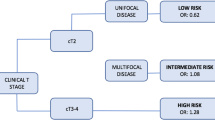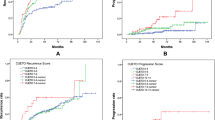Abstract
Purpose
To externally validate the Christodouleas risk model incorporating pathological tumor stage, lymph node (LN) count and soft tissue surgical margin (STSM) and stratifying patients who develop locoregional recurrence (LR) after radical cystectomy (RC) for urothelial carcinoma of the bladder (UCB). In addition, we aimed to generate a new model including established clinicopathological features that were absent in the Christodouleas risk model.
Methods
Prospectively assessed multicenter data from 565 patients undergoing RC for UCB in 2011 qualified for final analysis. For the purpose of external validation, risk group stratification according to Christodouleas was performed. Competing-risk models were calculated to compare the cumulative incidences of LR after RC.
Results
After a median follow-up of 25 months (interquartile range 19–29), the LR-rate was 11.5 %. The Christodouleas model showed a predictive accuracy of 83.2 % in our cohort. In multivariable competing-risk analysis, tumor stage ≥pT3 (HR 4.32, p < 0.001), positive STSM (HR 2.93, p = 0.005), lymphovascular invasion (HR 3.41, p < 0.001), the number of removed LNs <10 (HR 2.62, p < 0.001) and the administration of adjuvant chemotherapy (HR 0.40, p = 0.008) independently predicted the LR-rate. The resulting risk groups revealed significant differences in LR-rates after 24 months with 4.8 % for low-risk patients, 14.7 % for intermediate-risk patients and 38.9 % for high-risk patients (p < 0.001 for all), with a predictive accuracy of 85.6 %, respectively.
Conclusions
The Christodouleas risk model has been successfully externally validated in the present prospective series. However, this analysis finds that overall model performance may be improved by incorporating lymphovascular invasion. After external validation of the newly proposed risk model, it may be used to identify patients who benefit from an adjuvant therapy and suit for inclusion in clinical trials.



Similar content being viewed by others
References
Herr HW, Faulkner JR, Grossman HB et al (2004) Surgical factors influence bladder cancer outcomes: a cooperative group report. J Clin Oncol 22:2781–2789
Rink M, Lee DJ, Kent M et al (2013) Predictors of cancer-specific mortality after disease recurrence following radical cystectomy. BJU Int 111(3 Pt B):E30–E36
Christodouleas JP, Baumann BC, He J et al (2014) Optimizing bladder cancer locoregional failure risk stratification after radical cystectomy using SWOG 8710. Cancer 120(8):1272–1280
Froehner M, Novotny V, Wirth MP, et al (2014) External validation of a model to predict locoregional failure after radical cystectomy. Cancer. doi:10.1002/cncr.28876. [Epub ahead of print]
Aziz A, May M, Burger M et al (2014) Prediction of 90-day mortality after radical cystectomy for bladder cancer in a prospective European multicenter cohort. Eur Urol 66(1):156–163
Greene FL, Gospodarowicz M, Wittekend C et al (2009) American Joint Committee on Cancer (AJCC) staging manual, 7th edn. Springer, Philadelphia
Quek ML, Stein JP, Nichols PW et al (2005) Prognostic significance of lymphovascular invasion of bladder cancer treated with radical cystectomy. J Urol 174:103–106
Stenzl A, Cowan NC, De Santis M et al (2011) Treatment of muscleinvasive and metastatic bladder cancer: update of the EAU guidelines. Eur Urol 59:1009–1018
Rink M, Fajkovic H, Cha EK et al (2012) Death certificates are valid for the determination of cause of death in patients with upper and lower tract urothelial carcinoma. Eur Urol 61:854–855
Fine JP, Gray RJ (1999) A proportional hazards model for the subdistribution of a competing risk. J Am Stat Assoc 94:496–504
May M, Bastian PJ, Brookman-May S et al (2013) Gender-specific differences in cancer-specific survival after radical cystectomy for patients with urothelial carcinoma of the urinary bladder in pathologic tumor stage T4a. Urol Oncol 31:1141–1147
Harrell FE Jr, Lee KL, Mark DB (1996) Multivariable prognostic models: issues in developing models, evaluating assumptions and adequacy, and measuring and reducing errors. Stat Med 15:361–387
Visser O, Nieuwenhuijzen JA, Horenblas S (2005) Local recurrence after cystectomy and survival of patients with bladder cancer: a population based study in greater Amsterdam. J Urol 174:97–102
Volkmer BG, Kuefer R, Bartsch GC Jr et al (2009) Oncological followup after radical cystectomy for bladder cancer—is there any benefit? J Urol 181:1587–1593
Honma I, Masumori N, Sato E et al (2004) Local recurrence after radical cystectomy for invasive bladder cancer: an analysis of predictive factors. Urology 64(4):744–748
Hassan JM, Cookson MS, Smith JA Jr et al (2006) Patterns of initial transitional cell recurrence in patients after cystectomy. J Urol 175:2054–2057
Pollack A, Zagars GK, Cole CJ et al (1995) The relationship of local control to distant metastasis in muscle invasive bladder cancer. J Urol 154:2059–2063
Ide H, Kikuchi E, Miyajima A et al (2008) The predictors of local recurrence after radical cystectomy in patients with invasive bladder cancer. Jpn J Clin Oncol 38:360–364
Baumann BC, Guzzo TJ, He J et al (2013) A novel risk stratification to predict local-regional failures in urothelial carcinoma of the bladder after radical cystectomy. Int J Radiat Oncol Biol Phys 85:81–88
Skinner EC, Stein JP, Skinner DG (2007) Surgical benchmarks for the treatment of invasive bladder cancer. Urol Oncol 25:66–71
May M, Herrmann E, Bolenz C et al (2011) Association between the number of dissected lymph nodes during pelvic lymphadenectomy and cancer-specific survival in patients with lymph node-negative urothelial carcinoma of the bladder undergoing radical cystectomy. Ann Surg Oncol 18(7):2018–2025
Herr H, Lee C, Chang S et al (2004) Standardization of radical cystectomy and pelvic lymph node dissection for bladder cancer: a collaborative group report. J Urol 171:1823–1828
Novara G, Svatek RS, Karakiewicz PI et al (2010) Soft tissue surgical margin status is a powerful predictor of outcomes after radical cystectomy: a multicenter study of more than 4,400 patients. J Urol 183(6):2165–2170
Xylinas E, Rink M, Novara G et al (2013) Predictors of survival in patients with soft tissue surgical margin involvement at radical cystectomy. Ann Surg Oncol 20(3):1027–1034
Lotan Y, Gupta A, Shariat SF et al (2005) Lymphovascular invasion is independently associated with overall survival, cause-specific survival, and local and distant recurrence in patients with negative lymph nodes at radical cystectomy. J Clin Oncol 23:6533–6539
Shariat SF, Svatek RS, Tilki D et al (2010) International validation of the prognostic value of lymphovascular invasion in patients treated with radical cystectomy. BJU Int 105(10):1402–1412
Nakagawa T, Hara T, Kawahara T et al (2013) Prognostic risk stratification of patients with urothelial carcinoma of the bladder with recurrence after radical cystectomy. J Urol 189:1275–1281
Meeks JJ, Bellmunt J, Bochner BH et al (2012) A systematic review of neoadjuvant and adjuvant chemotherapy for muscle-invasive bladder cancer. Eur Urol 62(3):523–533
Booth CM, Siemens DR, Li G et al (2014) Perioperative chemotherapy for muscle-invasive bladder cancer: a population-based outcomes study. Cancer 120(11):1630–1638
Burger M, Mulders P, Witjes W (2012) Use of neoadjuvant chemotherapy for muscle-invasive bladder cancer is low among major European centres: results of a feasibility questionnaire. Eur Urol 61(5):1070–1071
Acknowledgments
We would like to thank the following colleagues for their valuable effort in the acquisition of data within our collaborative research group PROMETRICS 2011: Georg Bartsch, Christian Bolenz, Alexander Buchner, Sabine Brookman-May, Melanie Durschnabel, Jörg Ellinger, Galia Georgieva, Christian Gilfrich, Murat Gördük, Marc-Oliver Grimm, Boris Hadaschik, Florian Hartmann, Edwin Herrmann, Lothar Hertle, Markus Hohenfellner, Georg Janetschek, Nicole Kraischits, Annerose Krausse, Lukas Lusuardi, Thomas Martini, Roman Mayr, Maurice Stephan Michel, Rudolf Moritz, Stefan C. Müller, Sascha Pahernik, Armin Pycha, Jan Roigas, Christian Seitz, Shahrokh F. Shariat, Isabella Syring, Lutz Trojan, Florian Wagenlehner, Wolfgang Weidner, Manfred P. Wirth.
Conflict of interest
The authors declare that they have no conflict of interest.
Ethical standard
This study has been approved by the appropriate ethics committee and has therefore been performed in accordance with the ethical standards laid down in the 1964 Declaration of Helsinki and its later amendments. All persons gave their informed consent prior to their inclusion in the study
Author information
Authors and Affiliations
Corresponding author
Rights and permissions
About this article
Cite this article
Novotny, V., Froehner, M., May, M. et al. Risk stratification for locoregional recurrence after radical cystectomy for urothelial carcinoma of the bladder. World J Urol 33, 1753–1761 (2015). https://doi.org/10.1007/s00345-015-1502-y
Received:
Accepted:
Published:
Issue Date:
DOI: https://doi.org/10.1007/s00345-015-1502-y




